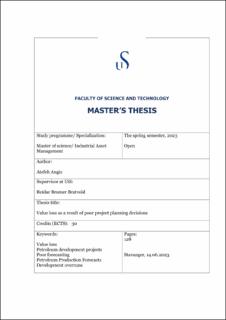| dc.description.abstract | The forecasts of development costs, schedules, and future productions, which are utilized to support investment decisions for projects, have a substantial impact on valuation and decision-making. However, many large projects, including petroleum projects on the Norwegian Continental Shelf (NCS), encounter cost and schedule overruns, as well as production shortfalls. Flyvbjerg [1] argued that exceeding budgeted time and costs is so prevalent in megaprojects that it can be considered a rule.
Although many studies worked on the cost and schedule overruns in various industries, the subject of production underperformance has not been widely covered.
This study builds upon the research conducted by Bratvold [2] and Nesvold [3], [4] regarding production forecasts for projects on the NCS. It involves the analysis of production shortfalls along with development time and cost overruns to evaluate the value loss arising from inaccurate forecasts.
The actual cost, time and production values are publicly available on the Norwegian Petroleum Directorate's (NPD) website [5]. Only the forecasted development costs and time schedule were publicly available, while the projected production values remained confidential.
Using the forecasted and actual values of the aforementioned data, this study aimed to identify overruns or underperformances, assess the economic value erosion caused by them, and examine the correlation between cumulative underperformances in the first 10 years of production and total cost overruns. For this purpose, the Present Value (PV) calculations were performed using two methods suggested by Mohus [6], in addition to Pearson, Spearman, and Support Vector Regression (SVR) analyses, utilizing MS Excel and Python.
After summarizing previous research on overruns and underperformances in various industries, an overview of the development project phases on the NCS and the study's methodology is provided. Based on the analyses conducted in this study, the results can be summarized as follows:
1) Utilizing development cost data from 142 projects with (Plan for Development and Operation) PDO approvals between 2001 and 2022, a total loss of NOK 268 billion was attributed to cost overruns. This indicates a 12.7% overrun of actual costs compared to the initial forecasted costs.
2) Analysing development time data for 76 oil fields with PDO approval from 1990 to 2019, the study found an average development delay of 101 days, resulting in a 12% schedule overrun compared to the initially forecasted development times. The forecasted value loss due to these delays amounted to approximately NOK 39 billion.
3) Examining production data from 67 oil fields with production spanning from 1995 to 2021, it was observed that an average of around 50 million Sm3 of oil was not delivered during the first 10 years of production, as initially forecasted. This accounts for a 5% underproduction. The forecasted value loss due to production shortfalls, considering only the mean forecasts, amounted to approximately NOK 80 billion.
4) The total value loss resulting from poor forecasts, when considering the first 10 years of production, was calculated to be NOK 387 billion, which is the cumulative sum of the previously mentioned figures.
5) The average correlation coefficients between the cumulative underproduction in the first 10 years and the total cost overruns, calculated using the Pearson, Spearman, and SVR methods, were 0.28, 0.08, and 0.41, respectively. The Pearson coefficient suggests a positive linear correlation, albeit a weak one. The Spearman coefficient indicates a very weak positive linear correlation between the ranks of the data. The SVR coefficient suggests a moderate correlation, which is non-linear, considering that the linear correlation coefficient is considerably smaller.
Moreover, the reasons for such poor forecasts, attributed to human bias, can be categorized as delusion, deception, and bad luck [7]. It is recommended that forecasters be trained about the biases and uncertainties involved in their forecasts, leverage the expertise of superforecasters, utilize historical data, and employ external methods like Reference Class Forecasting (RCF) to improve their forecasting accuracy [8].
To the best of the author's knowledge, based on data available until 2023, there has been no prior exploration of conducting a value loss analysis on the development time, cost, and production data for the first 10 years of production, along with regression analysis. This unique aspect distinguishes the present study from previous works. Considering the substantial value erosion resulting from inadequate forecasts in petroleum projects, it is vital for both the industry and the public to maintain diligent monitoring of project performance. | |
